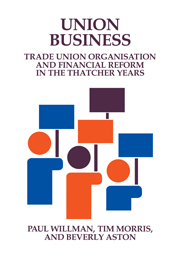Book contents
- Frontmatter
- Contents
- Acknowledgements
- 1 Introduction: unions in the 1980s
- 2 The financial status of British trade unions 1950–1989
- 3 Financial differences between unions
- 4 The role of financial matters in union organisation
- 5 The politics of union finaces
- 6 Union size, growth, and financial performance
- 7 Strike activity and union finances
- 8 The National Union of Mineworkers: strikes and financial disaster
- 9 The GMB: merger and financial reform
- 10 The Amalgamated Engineering Union: back from the brink
- 11 The Banking, Insurance and Finance Union: competitive unionism and financial survival
- 12 The Electrical, Electronic, Telecommunications and Plumbing Trade Union: accountability and financial control
- 13 Conclusions: union business and business unionism
- Appendix 1 Research methods
- Appendix 2 Regression results
- Appendix 3 Questions for finance officers
- Appendix 4 Questions for General Secretaries
- Appendix 5 Questionnaire: trade union finances
- Appendix 6 The number of trade unions
- Notes
- References
- Subject index
- Index of trade unions
- Author index
Appendix 1 - Research methods
Published online by Cambridge University Press: 11 March 2010
- Frontmatter
- Contents
- Acknowledgements
- 1 Introduction: unions in the 1980s
- 2 The financial status of British trade unions 1950–1989
- 3 Financial differences between unions
- 4 The role of financial matters in union organisation
- 5 The politics of union finaces
- 6 Union size, growth, and financial performance
- 7 Strike activity and union finances
- 8 The National Union of Mineworkers: strikes and financial disaster
- 9 The GMB: merger and financial reform
- 10 The Amalgamated Engineering Union: back from the brink
- 11 The Banking, Insurance and Finance Union: competitive unionism and financial survival
- 12 The Electrical, Electronic, Telecommunications and Plumbing Trade Union: accountability and financial control
- 13 Conclusions: union business and business unionism
- Appendix 1 Research methods
- Appendix 2 Regression results
- Appendix 3 Questions for finance officers
- Appendix 4 Questions for General Secretaries
- Appendix 5 Questionnaire: trade union finances
- Appendix 6 The number of trade unions
- Notes
- References
- Subject index
- Index of trade unions
- Author index
Summary
INTRODUCTION
This appendix focuses on the design of the research project. In practice, we are dealing with two distinct phases of research. The first, initially reported in Willman and Morris (1988), was based on the generally available data from the statutory returns, which we briefly describe. The second, from which our case studies emerged, was an attempt to understand financial management within trade unions. Data here included those from interviews and documentary material produced by trade unions themselves. It is thus appropriate to include a more detailed discussion of the two projects, before going on to a discussion of our questionnaire design and of the basis of case study selection. Initially, however, we must describe the statutory returns.
STATUTORY RETURNS BY TRADE UNIONS
Prior to 1971, all unions registered under the 1871 Trade Union Act were required to submit an annual financial return to the Registrar of Friendly Societies. From 1971 to 1974, under the Industrial Relations Act, a return was required to the Registrar of Trade Unions and Employers' Associations. The current reporting requirements are detailed in the Trade Union and Labour Relations Act 1974 and the Employment Protection Act 1975 ;2 the latter Act transferred the functions of the defunct Registrar of Trade Unions and Employers' Associations to the Certification Officer, who also took custody of returns dating back to 1871.
In brief, the requirements are as follows. Each union must, each calendar year, send a return to the Certification Officer detailing a ‘true and fair’ account of income, expenditure, and assets, an auditor's report, and a copy of the rules.
- Type
- Chapter
- Information
- Union BusinessTrade Union Organisation and Financial Reform in the Thatcher Years, pp. 217 - 224Publisher: Cambridge University PressPrint publication year: 1993



